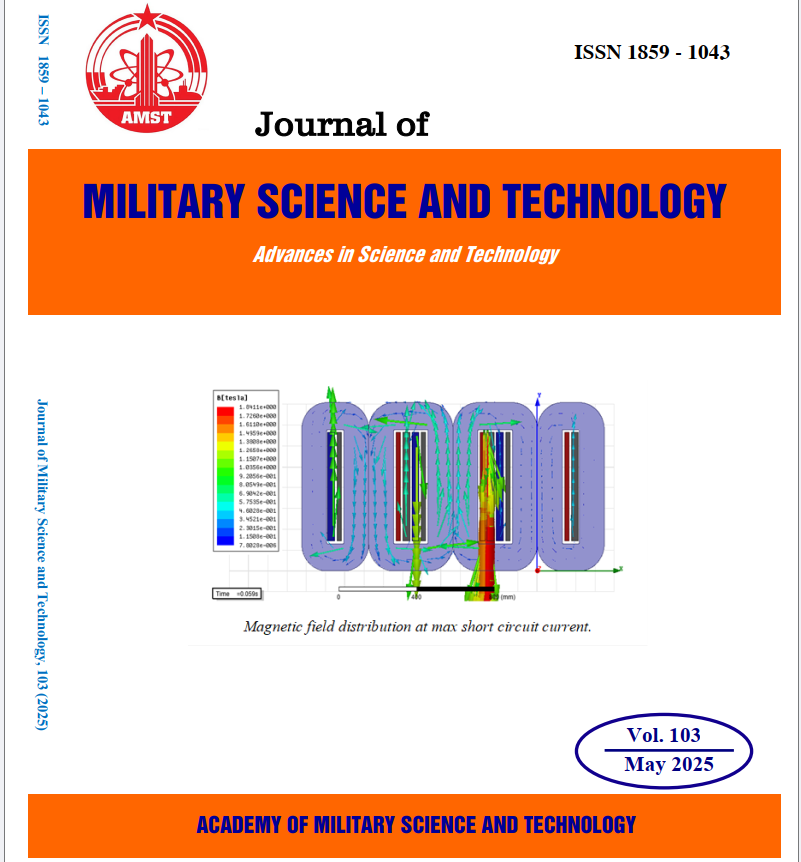Algorithm design and development for solving the target engagement problem on subsurface platforms
318 viewsDOI:
https://doi.org/10.54939/1859-1043.j.mst.103.2025.92-101Keywords:
Firing algorithm, Fire control problem solving, Subsurface platforms, Autonomous weaponsAbstract
Previous target engagement systems on subsurface platforms were electromechanical computers with highly complex mechanical structures, in which problems were idealized with predetermined parameters. With the current trend of digitalization, digital computers with high computational capabilities have replaced traditional electromechanical systems and are now installed and utilized on subsurface platforms. Based on theoretical studies of the AIUS (Automatic Information and Control System) on naval submarines, this paper presents research on the development of algorithms and software for target engagement using the established theoretical foundations. The proposed algorithm and software are then implemented and tested on a digital computer platform to evaluate their performance. The results demonstrate that the algorithm, when tested on a digital computer, achieves results comparable to those of electromechanical systems, with faster processing speed and the ability to adapt to continuous target movement.
References
[1]. Zhou, D., Mu, C. D., & Xu, W., "Fuzzy adaptive variable structure guidance with application to space interception", 1610–1614, (1999).
[2]. К.Ю. Шилов, "Основные аспекты создания интегрированных систем боевого управления перспективных напл для зарубежного заказчика." морской вестник (43), pp. 71-73, (2012).
[3]. Xiong, S. F., Wang, W. H., Liu, X. D., Wang, S., & Chen, Z. Q. "Guidance law against maneuvering targets with intercept angle constraint." *ISA Transactions*, Vol. 53, No. 4, pp. 1332-1342, (2014). DOI: https://doi.org/10.1016/j.isatra.2014.03.007
[4]. Shao, X. L., & Wang, H. J. "Back-stepping active disturbance rejection control design for integrated missile guidance and control system via reduced-order ESO." *ISA Transactions*, Vol. 57, (2015). DOI: https://doi.org/10.1016/j.isatra.2015.02.013
[5]. Ran, et al. "Backstepping design of missile guidance and control based on adaptive fuzzy sliding mode control." *Chinese Journal of Aeronautics*, Vol. 27, No. 3, pp. 634-642, (2014). DOI: https://doi.org/10.1016/j.cja.2014.04.007
[6]. АИУС ЛАМА-ЭКМ - ДАИЕ.466540.085-01 РЭ3.50. “Руководство по эксплуатации Использование по назначению. part 2.” Pp.4-43, (2012).
[7]. Fei Lei, Fuwen Tang, Sheng Li, “Underwater target detection algorithm based on improved YOLOv5”, Journal of Marine Science and Engineering, vol. 10, no. 3, article 310, (2022). DOI: https://doi.org/10.3390/jmse10030310
[8]. Qiang Liu, Wei Huang, Xiaoqiu Duan, Jianghao Wei, Tao Hu, Jie Yu, Jiahuan Huang, “DSW-YOLOv8n: A new underwater target detection algorithm based on improved YOLOv8n”, Electronics, vol. 12, no. 18, article 3892, (2023). DOI: https://doi.org/10.3390/electronics12183892
[9]. Maofa Wang, Chuzhen Xu, Chuanping Zhou, Youping Gong, Baochun Qiu, “Study on underwater target tracking technology based on an LSTM–Kalman filtering method”, Applied Sciences, vol. 12, no. 10, article 5233, (2022). DOI: https://doi.org/10.3390/app12105233







